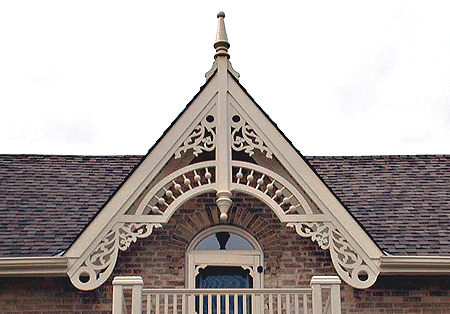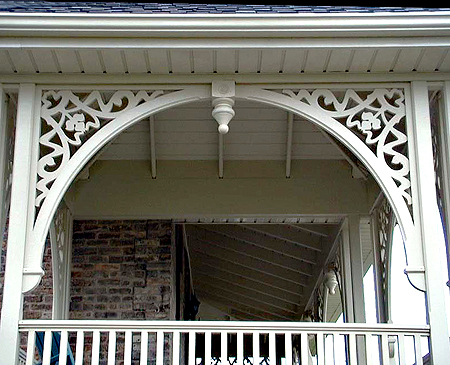Victorian Architectural Ornament
|
|||
My first contact with Joe Colucci, the proprietor of Gothom Inc. (manufacturers of custom Victorian style architectural ornament), came while I was restoring a large Victorian home in Troy, New York, some twelve or thirteen years ago. I think I found out about him in an Old House Journal reference. After several minutes on the telephone, I recognized a kindred spirit with a passion for Victoriana. I met him a year or so later in Port Huron, Michigan. Over the next months, while he helped with my front porch there, we collaborated on several other facades on the same street - part of a downtown restoration project I was involved with. Since then, he has become a fixture in my life. Here are a few biographic details. Growing up in Toronto in the 1960s and 1970s, Joe became acutely aware of its rich store of exuberant Victorian buildings, many over one hundred years old. It seemed to him that they dated back to the beginning of architectural time - after all, Canada was born while Queen Victoria reigned and was then celebrating its centenary. He recalls that some of the most beautiful structures fell to development. Books called Lost Toronto and Toronto - No Mean City chronicled the carnage; and many other buildings lost their incredible wooden ornamentation. By the early eighties the worst was over; conservationists had overcome. It became once again fashionable to own one of the city’s vast stores of tall and delightfully ornamented residential beauties. Property values justified restoration, and to underscore the antique phenomenon, the Victorian house became the ultimate antique. Joe bought his first Victorian in 1978 - a turreted Queen Anne overlooking Lake Ontario in Toronto’s west end. After three Victorian restorations, he acknowledged the need for restoration woodwork and in 1980 incorporated his company, Gothom Inc. Twenty seven years later Joe Colucci's activities still betray a partial dependence on restoration and reproduction work. His prime focus however is art, pure and simple. Convinced of the power of “fret” or “grille” work to convey beauty and drama - stylized or realistically - he tries to incorporate some form of it into almost everything he creates. Whether darkly silhouetted or gaily painted, in historical or contemporary settings Joe’s distinctive work, as evidenced by the following short collection of photos, still leaves me quite breathless. |
|||
|
|||
[Fig 1] The Lambton House or tavern, a popular watering hole until the early sixties, was restored almost twenty years ago according to original specifications. The most notable element in this porch is the hand-carved bracketing, which features a Gothic style quatrefoil design surrounded by two trefoils. This spiritual looking facade cleverly concealed the undoubtedly questionable activity conducted therein. |
|||
[Fig 2] The bargeboard (gable end ornament) on this heritage building was reproduced from pieces of the original. Though substantively a copy of the original design, the engineering and construction of this multi-layered work was improved to make it stronger and more water-shedding. This is an important requirement in freeze/thaw environments. The formal heavy moldings arranged geometrically in the upper layer starkly contrast this unusual combination of gothic tracery and colonial folk elements in the simply sawn lower layer. Both the paneled end posts and the king post are garnished with amusingly pompous-like turnings; this whole board is funny. The main repetitive cutouts suggest bugs and the lower running trim suggests waves or water. This makes one wonder if this imagery was accidental or intended, or only in the eye of the beholder. |
|||
|
|||
[Fig 3] This work, designed by Joe Colucci (henceforth marked DBJ), should score highly with all those romantics out there. The delicate and perfectly articulated scrollwork depicted in this construction photo adorns a remarkable boathouse in The Muskokas, north of Toronto. Outer repetitive elements, sporting flowers of choice, surround an enlarged centerpiece which uses posts decorated with Moorish pendants to support a center arch. The turned balls (barely visible in photo) attached to the spokes on the lower running trim are a nice whimsical touch. |
|||
|
|||
[Fig 4] This is one gable (DBJ) of many on the same home that features a ball and dowel arch suspended from a well proportioned king post and bracketed spire. The Art Nouveau/ Oriental looking squiggles in the surrounding scroll work are interesting here but are better expressed in the related photos of porch bracketing shown next. |
|||
|
|||
[Fig 5] These oversize elements, measuring about four feet by four feet, make quite an impression when so arranged over a very long porch. |
|||
|
|||
|
|||
|
|||
[Fig 7] This photo shows the front porch of Joe Colucci’s home/studio/office. The imposing work was designed, made, and in this case, even painted and installed by him. Note the mass and formality of the design; it appears to be a derivative of the renaissance revival style with large Tuscan columns and matching balusters. The dragon bellied corbels on each column top are absolutely lovely. The arcading formed in each bay or opening is accomplished by large and heavy brackets that enclose the image of a gilded cross - most appropriate for the location of “Salvation Corners” in Owen Sound - the site of four late Victorian stone churches. Standing on this porch feels very much like standing in the colonnaded cloister of a church. |
|||
|
|||
|
|||
[Fig 9] Moving on to interior decorations this arched piece (DBJ) was redesigned from a pattern in the Universal Design Book of 1904 and displays a stunning array of beads, dowels, small turnings and discs; acting almost as a crown for a ghoulishly scrolled centerpiece. I have seen this piece and can testify how incredibly it plays different light and how powerfully it affects space and mood. |
|||
|
|||
Almost as powerful is the smaller piece [Fig 10]. In this example (DBJ), the beads are intersected by dowels along two axis. This interlocking pattern influences the design possibilities as well as increasing the assembly difficulty. |
|||
|
|||
[Fig 11] This commemorative plaque (DBJ) shows the true exuberance of Joe’s “re-nouveau” scrollwork in a Christian setting. The importance and relationship of the frames to the subject is clearly visible in this riotous scrollwork rife with symbolism. As it turns out, this was a study for the much larger work depicted in [Fig 16]. Note the brass plate, the rosewood buttons, the red velvet backdrop and the stylized depiction of the church (from a photo. The light colored background is made of quarter cut white oak and the dark overlays are of black walnut. |
|||
As in the last piece, the frame components are as important as the subject. The puzzling asymmetrical spire toggles between a birdlike form and a lightning strike, depending on the view. |
|||
[Fig 13] depicts the original schematic line drawing presented to the client. |
|||
|
 |
||
[Figures 14 and 15] show the amazing details of this “Totem” sculpture. Holding it aloft is a sleepy two-headed carved lion. Down below a strikingly sculpted wolf-like creature cradles and protects the medallion. |
|||
|
|||
[Fig16] Standing eight feet tall, this art work (DBJ) is derived from the plaque in [Fig 11]. It is an elaborately designed marriage of wood, gilt, stained glass and jewels. Though never built, it was intended to be Joe Colucci’s definitive Christian piece. It may be difficult to understand at this small scale so zoom in if you can. The realistic depictions of three episodes in the life of Christ will astound you - there is even a real Biblical town portrayed in each scene. The frame scrollwork at the sides depicts the serpent and herald angels; at the top it spins itself into a dazzling representation of the risen Christ. To conclude, there is perilously little that Joe Colucci cannot make. Lately he has been back on the “architectural follies” bandwagon and is designing himself a house that looks like an owl, in the same spirit as the elephant in Cape May. I am hoping Joe will make me a Victorian bed. If you have a project, particularly if it is artistic or challenging, he will consider it. Photos or drawings or measurements may be required. To contact Joe Colucci personally, call (519) 371-8345. The physical office address is Gothom Inc., 963 4th Ave E., Owen Sound, Ontario, Canada N4K 2N9. |
|||






 This lovely panel [Fig 6], still in the shop in this photo, was intended for the side porch. Not depicted here, one large gable end on this house sports a matching bargeboard measuring three and one half feet wide and twenty six and one half feet down each side. That is one huge piece of work!
This lovely panel [Fig 6], still in the shop in this photo, was intended for the side porch. Not depicted here, one large gable end on this house sports a matching bargeboard measuring three and one half feet wide and twenty six and one half feet down each side. That is one huge piece of work!
 [Fig 8] Also in the shop, these colossal corbels (DBJ) were destined to support eaves on a new repro hillside home. Measuring eight inches wide, the largest projects fifty-six inches and is forty-eight inches high. They are framed and feature large curved plinths, rosettes, large round turnings, enclosed panels and one of his favorite features- the famous dragon’s belly. This photo is the last one depicting exterior work.
[Fig 8] Also in the shop, these colossal corbels (DBJ) were destined to support eaves on a new repro hillside home. Measuring eight inches wide, the largest projects fifty-six inches and is forty-eight inches high. They are framed and feature large curved plinths, rosettes, large round turnings, enclosed panels and one of his favorite features- the famous dragon’s belly. This photo is the last one depicting exterior work.


 [Fig 12] This flamboyant free standing piece (DBJ) called “Totem” was designed for the foyer in a home. The gilded base (not visible here) sits on the lower level while the medallion, featuring an imagined view of Georgian Bay looking east toward Blue Mountain, is viewed from the upper level.
[Fig 12] This flamboyant free standing piece (DBJ) called “Totem” was designed for the foyer in a home. The gilded base (not visible here) sits on the lower level while the medallion, featuring an imagined view of Georgian Bay looking east toward Blue Mountain, is viewed from the upper level.


